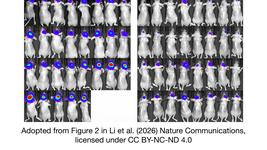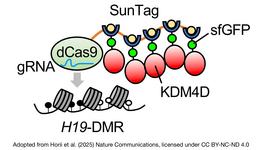CMN Weekly (29 August 2025) - Your Weekly CRISPR Medicine News
By: Gorm Palmgren - Aug. 29, 2025
CMN Intelligence - The World’s Most Comprehensive Intelligence Platform for CRISPR-Genomic Medicine and Gene-Editing Clinical Development
Providing market intelligence, data infrastructure, analytics, and reporting services for the global gene-editing sector. Read more...
Top picks
- Engineered variants of Cas12i.3, termed EOCas12i-Combo1 and Combo2, achieved up to 60-fold higher editing efficiency than wild-type while maintaining high specificity and producing large indels. Optimised through crRNA design, codon usage, and mutations, these systems enabled multiplexed editing of up to 30 targets via compact crRNA arrays, performing comparably to SpCas9 and LbCas12a. EOCas12i platforms expand efficient and scalable genome editing capabilities.
- CRISPR-Cas interference screening of colorectal tissue epigenomes identified 265 functional cis-regulatory elements driving CRC proliferation. Integrating these with a polygenic risk score enabled accurate prediction of CRC and precancerous lesions in nearly half a million individuals. Mechanistically, variant rs10871066 reprograms a silencer into an enhancer via the FOXP1–TCF7L2 axis, activating KLF5 and PIBF1 to promote tumour growth and immune evasion, thereby illuminating noncoding drivers of CRC.
Research
- CRISPR-Cas9 knockout of miR-30a-5p modestly enhanced enucleation in the immortalised erythroid line imBMEP-A, but transcriptomic and proteomic profiling revealed c-Myc-driven disruptions in metabolism, apoptosis, and cytoskeletal regulation. Optimising cells via BCL-XL activation and SCIN knockout restored actin organisation and improved survival. They boosted terminal erythropoiesis, producing 22% more orthochromatic erythroblasts, advancing scalable in vitro red blood cell production for therapeutic applications.
- CRISPR-Cas epigenetic editing with dCas9-TET1 was used to demethylate the miR-200c promoter in breast cancer cells, restoring its expression. Dual gRNAs enhanced reactivation, suppressing EMT drivers ZEB1, ZEB2, and KRAS, while inducing E-cadherin in MDA-MB-231 cells. This reprogramming reduced viability and promoted apoptosis, particularly in highly methylated cells, highlighting context-dependent but promising therapeutic potential for targeted reversal of tumour epigenetic silencing.
- CRISPR-Cas transcriptional activation systems, particularly SAM-based designs using p65 and HSF1 activation domains, were found to cause significant cytotoxicity. Expression in lentiviral producer cells reduced viral titres, while expression in target cells induced cell death. No safe activation window was identified, highlighting toxicity as a significant barrier to CRISPRa applications and underscoring the need for redesigned activators balancing efficiency with cellular safety.
- CRISPR-Cas transposase PseCAST was structurally characterised by cryo-EM, revealing subtype-specific DNA recognition features. Guided by these insights, researchers engineered variants with improved integration efficiency and altered PAM requirements. Hybrid CASTs, which combine distinct DNA-binding and integration modules, were also developed, demonstrating strategies to overcome binding bottlenecks and expand the potential of DSB-free genome editing in human cells.
- An evolutionary scale language model trained on CRISPR-Cas data enabled alignment-free discovery of undocumented Cas proteins, revealing seven novel Cas12a subtypes and distinct Cas1–Cas4 variants. Structural and cryo-EM analyses showed unique RNA interactions, diverse cleavage modes, and broad PAM recognition. Machine learning–guided predictions enabled SNP detection without canonical PAMs, demonstrating the power of language models in accelerating functional exploration of uncharacterised CRISPR-Cas systems.
Delivery
- Researchers have developed RENDER, a delivery system that enables the transient introduction of CRISPR-Cas epigenome editors as ribonucleoproteins. The platform supports both gene repression and activation, achieving durable silencing in diverse human cell types, including primary T cells. In stem cell-derived neurons, RENDER repressed disease-associated Tau expression, demonstrating its potential for precise, non-DSB epigenetic editing in research and therapeutic contexts.
- A proposed strategy utilises engineered Japanese encephalitis virus as a self-replicating nanocarrier for the delivery of CRISPR-Cas9 or antisense oligonucleotides to motor neurons in ALS. Exploiting its neurotropism and immune cell–mediated CNS entry, the approach could bypass brain and spinal cord barriers, enabling sustained therapeutic expression. Safety and efficacy remain untested, but the framework suggests a potentially transformative CNS gene therapy platform.
Screening
- CrAAVe-seq, an AAV-based CRISPR screening platform, enables pooled, cell-type-specific genetic screens in vivo using Cre-sensitive sgRNA constructs. Applied in mouse brains, it targeted over 5,000 genes and identified neuronal survival regulators, including Rabggta and Hspa5. The study establishes scalability, reproducibility, and performance parameters, providing a framework for large-scale functional genomics in defined mammalian cell populations.
- CRISPR-Cas9 screening identified STAT6 as a driver of celecoxib resistance in liver cancer through the activation of ALOX and CYP enzymes, enabling the shunting of arachidonic acid. STAT6 knockdown or inhibition with AS1517499 blocked this compensatory pathway, markedly enhancing celecoxib sensitivity in vitro and in vivo. The findings suggest that STAT6 inhibition is a promising strategy for overcoming resistance and improving the therapeutic efficacy of celecoxib in liver cancer.
- CRISPR-Cas9 screening identified SUV39H2 as a barrier to oncolytic HSV-1 replication in oral squamous cell carcinoma. SUV39H2 suppressed viral gene transcription via H3K9 trimethylation, while its inhibition with OTS186935 enhanced replication and tumour clearance in mice. Knockdown also boosted T cell infiltration, suggesting that targeting SUV39H2 could improve both viral propagation and antitumour immunity, offering a promising strategy to enhance oncolytic virotherapy efficacy.
- An optimised CRISPR-Cas9 knockout library, Jacquere, was developed using Rule Set 3 to enhance guide efficacy prediction. The design incorporates a refined strategy that selectively omits guides with excessive off-target risk while retaining highly active candidates, improving genome-wide coverage. Validated for human cells, Jacquere offers a compact, updated resource for high-dimensional CRISPR screens, enabling efficient functional genomics at scale.
Clinical and preclinical
- YolTech Therapeutics announced that the EMA granted Orphan Drug Designation to YOLT-203, its in vivo gene-editing therapy for Primary Hyperoxaluria Type 1 (PH1). Already holding FDA orphan and rare paediatric disease designations, YOLT-203 targets the HAO1 gene to inactivate glycolate oxidase, reducing oxalate precursor synthesis. Interim trial data (NCT06511349) show strong safety and urinary oxalate reduction, supporting its potential as a one-time treatment for PH1.
Industry
- Wugen has raised $115 million in equity financing, led by Fidelity, to advance its pivotal T-RRex trial of WU-CART-007 (soficabtagene maraleucel), a CRISPR-edited, CD7-targeted allogeneic CAR-T therapy for relapsed/refractory T-ALL and T-LBL. Phase 1/2 results showed 91% ORR and 73% CRc, with >6-month median response and manageable safety. The pivotal study supports a planned BLA filing in 2027, positioning WU-CART-007 as the first off-the-shelf CAR-T for T-cell malignancies.
Reviews
- Hearing loss: a global view for gene therapy approaches and challenges. This review examines gene therapy strategies for hearing loss, outlining both gene-dependent and gene-independent approaches, as well as delivery methods, administration routes, and the remaining challenges.
- Revealing genetic drivers of ovarian cancer and chemoresistance: insights from whole-genome CRISPR-knockout library screens. This review examines how whole-genome CRISPR-knockout library screens reveal genetic dependencies in epithelial ovarian cancer, facilitating biomarker discovery, identification of synthetic lethal targets, and strategies to enhance treatment responses.
- CRISPR and RNA Interference: Revolutionary Tools for Extending Food Shelf Life and Ensuring Safety. This review evaluates the applications of CRISPR and RNAi in food preservation and safety, comparing their efficiency in delaying ripening, enhancing resistance, and reducing pathogens, while addressing regulatory, ethical, and translational challenges.
- CRISPR tools for T cells: targeting the genome, epigenome, and transcriptome. This review explores how CRISPR technologies are advancing T cell engineering to overcome therapeutic challenges, enhance efficacy in solid tumours, and drive the next generation of cellular therapies.
News from CRISPR Medicine News
- On Wednesday, we reported that Axelyf will advance its potent RNA delivery platform after securing $2.6 million in seed financing to develop further its proprietary lipid nanoparticle (LNP) delivery technology. In mouse studies, AXL LNPs encapsulating CRISPR components achieved approximately four- to five-fold higher gene editing efficiency in the liver at moderate doses compared to LP-01, without evidence of liver toxicity.
To get more CRISPR Medicine News delivered to your inbox, sign up to the free weekly CMN Newsletter here.
“The European Genomic Medicine Consortium is quietly gathering under the CMN umbrella. Exploring the frontier of gene editing for therapeutic precision - this network is not public yet, but it’s real. Watch the signals, track the sequences. Only those who search will know.”R
Tags
CLINICAL TRIALS
IND Enabling
Phase I
Phase II
Phase III
Gastric Cancer and Colorectal Cancer, CRC, (NCT07166263)
Sponsors:
Base Therapeutics (Shanghai) Co., Ltd.
Sponsors:
Base Therapeutics (Shanghai) Co., Ltd.
IND Enabling
Phase I
Phase II
Phase III
Relapsed or Refractory Acute Myeloid Leukemia, AML, (NCT06541444)
Sponsors:
Base Therapeutics (Shanghai) Co., Ltd.
Sponsors:
Base Therapeutics (Shanghai) Co., Ltd.
IND Enabling
Phase I
Phase II
Phase III







